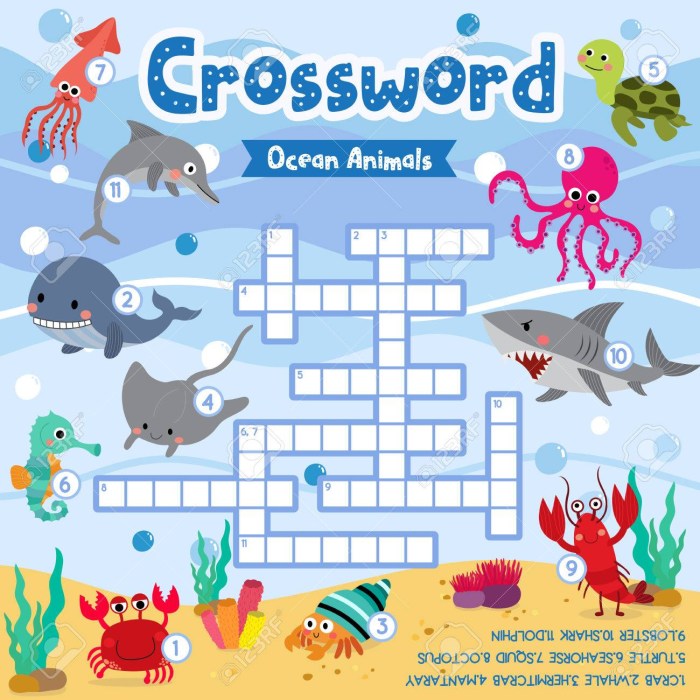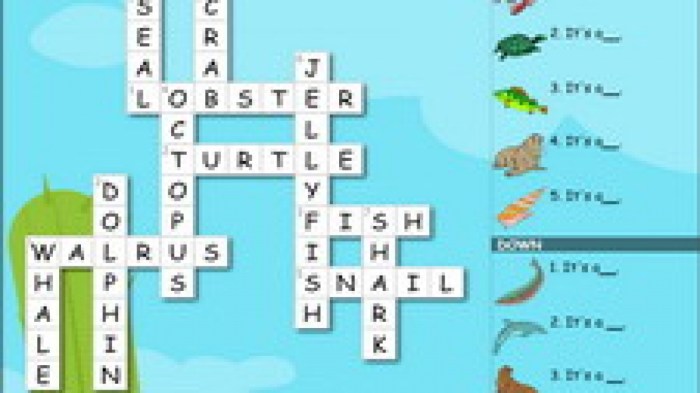Key in the sea crossword – Dive into the enigmatic world of “key in the sea” crossword clues, where wordplay intertwines with marine biology, history, and art. Get ready to unlock the hidden meanings and discover the fascinating connections between these seemingly disparate realms.
From the diverse species of keys that inhabit the ocean’s depths to the cultural significance of keys in maritime traditions, this exploration delves into the multifaceted nature of “key in the sea” clues, enhancing your crossword-solving experience.
Wordplay and Definitions

Wordplay is a crucial element in crossword puzzles, adding an extra layer of challenge and enjoyment to the solving process. It involves using words or phrases in a clever or ambiguous way to create clues that require lateral thinking and linguistic agility to decipher.
Types of Wordplay
- Homophones:Words that sound the same but have different spellings and meanings (e.g., “key” and “quay”).
- Anagrams:Words formed by rearranging the letters of another word (e.g., “listen” can become “silent”).
- Hidden Words:Words concealed within other words or phrases (e.g., “tea” is hidden in “teapot”).
- Puns:Humorous plays on words that exploit multiple meanings (e.g., “What do you call a fish with no eyes? Fsh!”).
Wordplay adds depth and complexity to crossword clues, encouraging solvers to think creatively and engage with language in a playful and stimulating way.
When you’re puzzling over a “key in the sea” crossword clue, it’s easy to get stumped. But don’t worry, you can always turn to the trusty Wordly Wise Book 2 PDF for help. With its comprehensive vocabulary and definitions, you’ll be able to find the answer you need in no time.
And when you’re done, you can go back to your crossword puzzle and finish it off with ease.
Marine Biology and Oceanography
The presence of keys in marine environments is a fascinating aspect of marine biology and oceanography. These enigmatic creatures play a significant role in the intricate web of marine ecosystems and are influenced by specific oceanographic conditions.
Species Diversity of Keys in Marine Environments
Marine environments harbor a diverse array of key species, each with unique characteristics and adaptations. The most common types of keys found in the sea include:
- Sand keys: Formed by the accumulation of sand and debris, these keys are typically found in shallow waters near the shoreline.
- Coral keys: Constructed by the accumulation of coral skeletons, these keys are found in tropical and subtropical regions with clear waters and abundant sunlight.
- Volcanic keys: Originating from volcanic eruptions, these keys are formed when lava flows into the sea and cools, creating new landmasses.
li>Mangrove keys: Formed by the growth of mangrove trees in shallow waters, these keys provide important habitats for various marine organisms.
Ecological Role of Keys in Marine Ecosystems
Keys play a vital role in the functioning of marine ecosystems:
- Habitat provision: Keys provide shelter and breeding grounds for a wide range of marine species, including fish, invertebrates, and seabirds.
- Nutrient cycling: The vegetation and organic matter found on keys contribute to nutrient cycling within the ecosystem, supporting the growth of primary producers.
- Erosion protection: Keys act as natural barriers, protecting coastlines from erosion caused by waves and storms.
- Biodiversity hotspots: Keys often support a high level of biodiversity, serving as important areas for conservation and research.
Oceanographic Conditions Supporting Key Formation
The presence of keys in the sea is influenced by specific oceanographic conditions:
- Water temperature: Keys are typically found in warm, tropical and subtropical waters, where temperatures support the growth of coral and other marine organisms.
- Salinity: Keys require relatively high salinity levels, as low salinity can hinder the growth of coral and other key-forming organisms.
- Wave energy: Moderate wave energy is necessary for the formation and maintenance of keys. Excessive wave energy can erode keys, while insufficient wave energy can lead to sedimentation and smothering.
- Nutrient availability: Keys require access to nutrients for the growth of vegetation and other organisms. Nutrient-rich waters promote the development of healthy key ecosystems.
Historical and Cultural Context

Keys have played a pivotal role in maritime contexts throughout history, symbolizing authority, security, and the unlocking of new horizons.
In ancient times, keys were often used as symbols of power and authority. For instance, in ancient Egypt, the pharaohs carried golden keys as a symbol of their divine right to rule. Similarly, in ancient Greece, the god of the sea, Poseidon, was depicted holding a key, representing his dominion over the oceans.
Keys in Maritime Traditions
Keys have also been closely associated with maritime traditions. In many cultures, keys were believed to possess magical powers, capable of protecting sailors from storms, pirates, and other perils of the sea. Sailors often carried keys as talismans, believing they would bring good luck and safe passage.
Keys were also used in practical ways in maritime contexts. For example, they were used to secure hatches, chests, and other valuable items on ships. In the Royal Navy, keys were used to identify officers and their rank. The size and ornamentation of the key indicated the officer’s seniority.
Keys in Mythology and Folklore
Keys have featured prominently in mythology and folklore related to the sea. In Greek mythology, the goddess Amphitrite, wife of Poseidon, was said to possess a golden key that unlocked the gates of the underwater kingdom.
In many cultures, keys are associated with mermaids, mythical creatures that are half-human and half-fish. Mermaids are often depicted holding keys, which are said to unlock the secrets of the sea or to grant wishes.
Literary and Artistic Depictions: Key In The Sea Crossword
The theme of “keys in the sea” has resonated with artists and writers throughout history, offering a rich tapestry of interpretations and symbolism.
In literature, keys have been used as metaphors for unlocking secrets, hidden knowledge, or profound mysteries. For instance, in Herman Melville’s “Moby-Dick,” the elusive white whale is often depicted as a key to unlocking the secrets of the universe.
Paintings and Sculptures
In the visual arts, keys have been portrayed in a variety of ways, often embodying the symbolism of hidden knowledge or power. For example, in J.M.W. Turner’s painting “The Key to the Lock,” a golden key is depicted as a symbol of unlocking the mysteries of nature and the unknown.
Other Artistic Mediums, Key in the sea crossword
Beyond paintings and sculptures, keys have also found expression in other artistic mediums. In music, for instance, the “key” refers to the tonal center of a piece, providing a framework for the composition. In theater, keys have been used as props to symbolize the unlocking of hidden chambers or the revelation of secrets.
Essential Questionnaire
What is the significance of wordplay in crossword puzzles?
Wordplay forms the foundation of crossword puzzles, adding an element of challenge and intellectual stimulation. It enhances the enjoyment of solving by requiring players to think creatively and decipher hidden meanings.
How do keys relate to marine ecosystems?
Keys, such as sea urchins and starfish, play crucial ecological roles in maintaining the health and balance of marine environments. They contribute to nutrient cycling, control algal growth, and provide food for other organisms.
What historical uses have keys served in maritime contexts?
Keys have been essential in maritime navigation, unlocking access to harbors, securing ships, and symbolizing authority and ownership. They have also held cultural and religious significance, representing protection, good fortune, and the connection between land and sea.